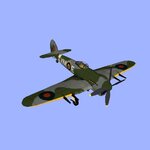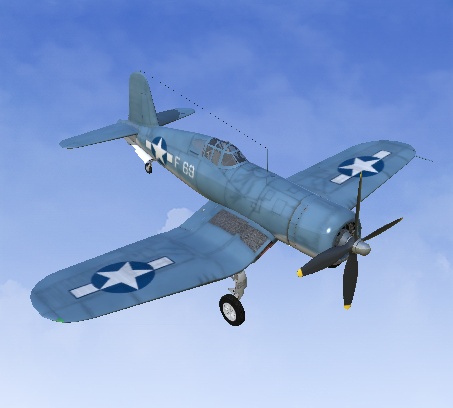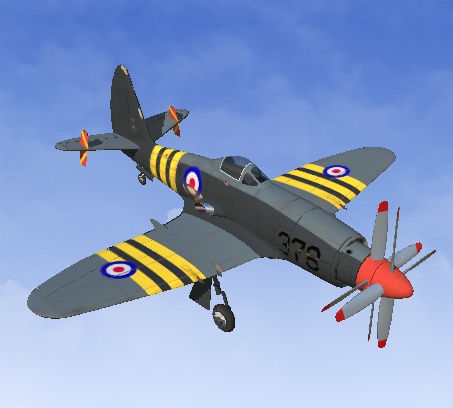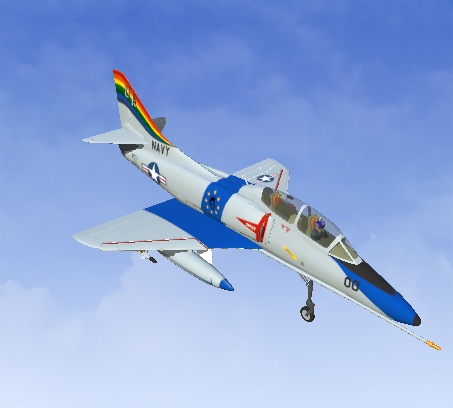Hawker Typhoon 4 in 1/3.8 or 1/4 scale. Later production 4 blade version. Have Fun!
Typhoon Facts:
Even before the new Hurricane was rolling off the production lines in March 1937, Sydney Camm had moved on to designing its future replacement as a private project. This was to be a massive plane designed around the equally massive Napier Sabre engine. The work proved useful when Hawker received specification F.18/37 in January 1938 from the Air Ministry, which asked for a fighter based around either the Napier Sabre or the Rolls-Royce Vulture engine. The engines were similar in that they were both 24 cylinder designs that were designed to deliver over 2,000 hp (1.5 MW); the difference between the two being, primarily, in the arrangement of the cylinders — an H-block in the Sabre and an X-block in the Vulture.
RAF Typhoon at RAF Hendon Museum clearly showing the large "chin" radiator beneath the nose
RAF Typhoon at RAF Hendon Museum clearly showing the large "chin" radiator beneath the nose
The two resulting models became known as the "R" and "N" (based on the engine manufacturer) and were very similar—the Vulture-powered R plane (the Tornado) had a rounder nose profile and a ventral radiator, whereas the Sabre-powered N (the Typhoon) had a flatter deck and a chin mounted radiator. The basic design of both continued the Hawker tradition of using "older" construction techniques; the front fuselage was welded steel just like the Hurricane, and the design used a massive 40 foot (12 m) wing that was much thicker than those on designs like the Spitfire. Camm did give in to the times for much of the rest of the plane though; it was semi-monocoque from the cockpit rearward, flush riveted, and had wide set gear. Instead of a sliding or lifting canopy the Typhoon was first produced with a side door.
Typhoon Facts:
Even before the new Hurricane was rolling off the production lines in March 1937, Sydney Camm had moved on to designing its future replacement as a private project. This was to be a massive plane designed around the equally massive Napier Sabre engine. The work proved useful when Hawker received specification F.18/37 in January 1938 from the Air Ministry, which asked for a fighter based around either the Napier Sabre or the Rolls-Royce Vulture engine. The engines were similar in that they were both 24 cylinder designs that were designed to deliver over 2,000 hp (1.5 MW); the difference between the two being, primarily, in the arrangement of the cylinders — an H-block in the Sabre and an X-block in the Vulture.
RAF Typhoon at RAF Hendon Museum clearly showing the large "chin" radiator beneath the nose
RAF Typhoon at RAF Hendon Museum clearly showing the large "chin" radiator beneath the nose
The two resulting models became known as the "R" and "N" (based on the engine manufacturer) and were very similar—the Vulture-powered R plane (the Tornado) had a rounder nose profile and a ventral radiator, whereas the Sabre-powered N (the Typhoon) had a flatter deck and a chin mounted radiator. The basic design of both continued the Hawker tradition of using "older" construction techniques; the front fuselage was welded steel just like the Hurricane, and the design used a massive 40 foot (12 m) wing that was much thicker than those on designs like the Spitfire. Camm did give in to the times for much of the rest of the plane though; it was semi-monocoque from the cockpit rearward, flush riveted, and had wide set gear. Instead of a sliding or lifting canopy the Typhoon was first produced with a side door.






